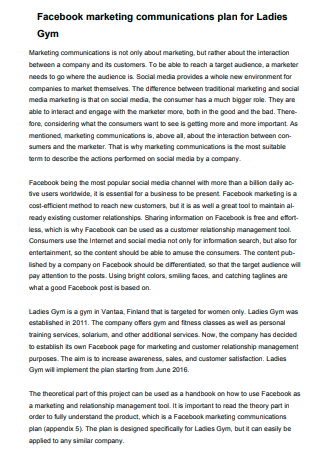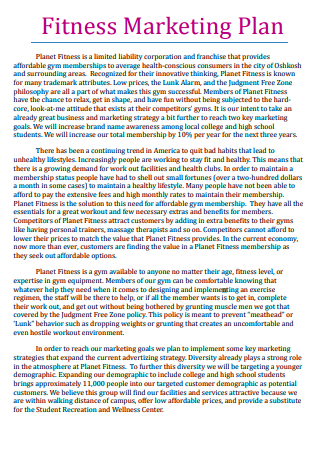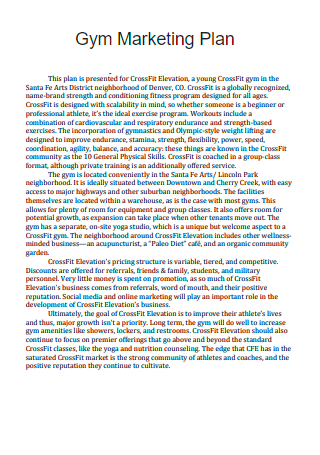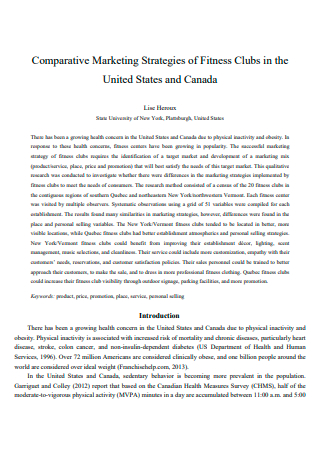3+ Sample Gym Marketing Plan
FREE Gym Marketing Plan s to Download
3+ Sample Gym Marketing Plan
The Gym Marketing Plan: What Is It All About?
Top 4 Gym Marketing Strategies
Creating a Gym Marketing Plan
What are the other ways to successfully market a gym?
What are the usual services offered and equipment found in a gym facility?
What are some of the expenses involved in a gym business operation?
The Gym Marketing Plan: What Is It All About?
If you caught yourself thinking about heading to the gym and doing some bone-breaking, booty sweat workouts because you wanted to look like the next Kendall Jenner, then yes, that is what a gym marketing plan is all about. A gym marketing plan is a documented strategy that aims to create leads, attract potential clients or customers, reach out to old and new target markets, with the intent to increase sales revenue through gym membership fees and other value-added services. Gyms rely on membership fees to keep their operations up and running. To do that, marketing strategies are created around concepts of beauty and lifestyle, creating a need to live a healthier lifestyle, or else adopt role models that represent what it means to be fit and healthy. When we think about gyms, what comes to mind are these large function rooms with workout equipment placed side by side, and people in them are either running, pushing, or grinding. We also have this picture of gym instructors counting down, or sometimes barking out instructions or phrases of what appears to be motivating for the customers. A lot of work has been put into creating that mastermind gym marketing plan. To stay on top of the game and to continue operating, gyms must keep up with the times with updated marketing campaigns, and develop SMART goal-type strategies. Out with the old, in with the new, as they say.
Top 4 Gym Marketing Strategies
Gym marketing strategies are all about gaining new members. Strategies should be created based on the SMART method; Smart, Measurable, Achievable, Relevant, and Time-bound. The traditional method of packing your bags and heading out to the nearest gym still exist, but more innovative methods of working out keep on coming out of the woodwork, such as websites showcasing gym workout routines that you can either download or watch the live stream, workout digital apps that you can download and do your exercise at anywhere and anytime and even social media have broadened through social networking platforms, such as doing Zoom workout classes. As there is a lot to contend with in this day and age for gyms to keep up, marketing strategies should remain focused on the goal of what a gym wishes to accomplish. Here are some of the proven effective top marketing gym strategies.
Creating a Gym Marketing Plan
A brand new gym with shiny new equipment and a fantastic workout ambiance is nothing without its gym clientele. What makes a gym come to life are the people working out on the treadmills, the bars and benches, the dumbbells and the barbells, the stationary bikes, the people dancing in aerobics classes, and not to mention the sweaty yet motivating atmosphere. Membership is what keeps a gym up and running. To inspire, motivate, and encourage more members to join, a good and effective gym marketing plan is a must. There are a lot of formats that can be used in creating a gym marketing plan, but here are the essential elements that you need to know when you’re planning on making one.
-
Step 1: Defining the Executive Summary
The Executive Summary of a gym marketing plan essentially gives an overview of how you intend to reach your target market and increase gym membership enrollment. It also provides a brief background of the gym, along with its culture and values. An executive summary can also contain the mission and vision statements. The Mission Statement provides the intent behind the marketing plan, what its goals and objectives are. The Vision Statement paints a picture of what you hope the marketing plan achieves in a given period. The executive summary, including the mission and vision statements, should overall set the tone of the whole marketing plan to motivate and provide a call for action.
-
Step 2: Analyzing the Market Condition
Often known as the Market Analysis, analyzing the market condition will help determine if there is a niche in the market for the product or service offered, or will also determine how well can the product or service penetrate the current market. To do this, you need first to identify who are your target customers by doing a demographics classification. This is done by categorizing customers according to their age, gender, lifestyle, income, location, et cetera. Next is by doing a SWOT Analysis. SWOT analysis in a gym marketing plan is identifying the Strengths of the gym, such as what makes it stand out from its competition; identifying the Weaknesses, or what factors are hindering the gym from becoming a successful business such as low membership enrollment, lack of resources or equipment, lack of funding, and so on; identifying the Opportunities, such as taking advantage of digital media platforms to increase advertising campaigns; and identifying Threats, which are factors that could potentially harm a gym’s operation like an increase of competitors presence, an increase of workout online trends that could discourage a customer from going to an actual gym, or health crises that prevent members from going to the gym, like the recent pandemic.
-
Step 3: Gym Marketing Tactics
This is where you present your gym marketing strategies. Keep in mind that the intent of creating your marketing strategies for a gym marketing plan, aside from increasing gym membership enrollment, is to provide solutions to your clienteles’ needs, and to present value-added service for health and fitness that your clients can greatly benefit from. Marketing strategies should also be bound to a timeline so that you can be able to monitor how far you are on accomplishing your goals. Some of the marketing strategies we have identified are creating an online presence through social media, and referral and affiliate programs. Be sure to always review the progress of your marketing strategies, and be ready to make some revisions as necessary.
-
Step 4: Financial Reviews
Having a budget and knowing what expenses you’re up against is an essential part of a gym marketing plan. A financial review includes a balance sheet that shows the gym’s assets, its liabilities, and its other investments. It also contains the budget on hand, versus the startup costs and the overhead expenses. A financial review can also give projections of how much the gym will increase its revenue based on the marketing campaigns and strategies. Having a well-drafted financial review helps influence decision making, especially when it comes to creating marketing strategies. It also determines how healthy the current status of the business is when it comes to its finances. If there is a need to secure additional funding and resources, a financial review can be able to point that out, and the review can be used as a presentation for potential investors. Be sure to be accurate and transparent when presenting the numbers, so that you will have a realistic view of the market outcome.
FAQs
What are the other ways to successfully market a gym?
Aside from the usual gym marketing strategies, here are some ways in which you can effectively market a gym: 1) Offer a free-day pass – A free-day pass can allow potential customers to get the feel of what it’s like working out in the gym and will also allow them to use the gym’s different facilities and equipment.; 2) Use brand ambassadors, celebrities, or social media influencers to promote the gym.; 3) Hosting a competition wherein the winner gets a one-year free membership gym pass.; 4) Provide value-added services, such as free massage for new gym members, or free consultations with licensed health professionals.; and 5) Promotional giveaways for every visit to the gym, whether to sign up or just to inquire, visitors get freebies such as tumblers, caps, towels, mugs, et cetera.
What are the usual services offered and equipment found in a gym facility?
Gyms offer several health and fitness services such as personal fitness training; classes like aerobics dance class, yoga, body pump, spinning, Zumba, circuit training, et cetera; or spa, and physiotherapies, and so on. Typical gym equipment is training benches, treadmills, stationary bicycles, rowing machines, fitness ball, kettlebell set, dumbbell set, barbell set, pull-up bars, and also sometimes even a swimming pool and a sauna or steam rooms.
What are some of the expenses involved in a gym business operation?
Common expenses found in a gym business operation are the startup and operating costs. Startup costs are the expenses required to launch the gym, such as licensing and permits, registrations, insurance, office and accounting supplies, marketing costs, and tools and equipment. Operating costs are the expenses incurred during the day-to-day operation of the gym, like the payment for utilities, maintenance, payroll, rental fee (if applicable), and the overall administrative and marketing expenses.
That’s right. It’s a “no pain, no gain” situation when it comes to marketing a gym. The pain comes in the form of effective planning and strategizing, and the gain comes in the form of increased gym membership enrollment. Going to the gym is more than just coming out and looking like America’s next top model. It’s about the understanding of the important need of exercising, of working out to achieve the overall optimal health through a good health and fitness lifestyle. And that’s what a gym marketing plan is aiming for.
Creating a gym marketing plan isn’t that hard to do. With the help of our marketing plan templates that you can download, you can be able to draft your own personalized gym marketing plan in no time! Check out our templates, and start taking those steps towards a successful gym marketing campaign.




